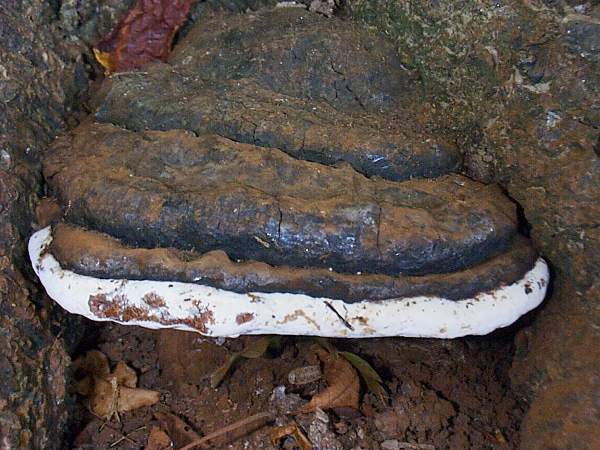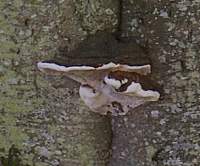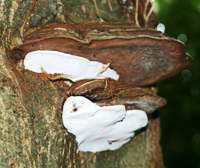Trees Birds Mammals Fish Amphibians Reptiles
Wild Algarve
Bookshop
Ganoderma australe ( Fr.) Pat. - Southern Bracket
Phylum: Basidiomycota - Class: Agaricomycetes - Order: Polyporales - Family: Ganodermataceae
Distribution - Taxonomic History - Etymology - Identification - Culinary Notes - Reference Sources

Ganoderma australe (syn. Ganoderma adspersum (Schulz.) Donk.) is a common perennial bracket fungus that causes white heart rot in trees of the genera Tilia (limes), Quercus (oaks), Fagus (beech, birch etc), Platanus (Sycamore etc) and Aesculus (Horse Chestnut and relatives). In the early stages of colonisation it is thought to be a parasitic fungus, but as the tree dies it becomes saprobic, as most parasitic fungi do. The perennial fruitbodies of Gamoderma australe appear mainly on the lower trunk, most often near to the base.
This tough, inedible bracket lives for many years, developing noticeable growing ridges on the upper surface.

Distribution
Widespread and common in Britain and Ireland, Ganoderma australe is found throughout most of mainland Europe and is most common in central and northern Europe.
Taxonomic history
The great Swedish mycologist Elias Magnus Fries described this species in 1828 and named it Polyporus australis. Its current scientific name comes from a 1889 publication by French pharmacist and mycologist Narcisse Théophile Patouillard (1854 - 1926).
Synonyms of Ganoderma australe include Polyporus australis Fr., Polyporus adspersus Schulzer, Fomes australis (Fr.) Cooke, Ganoderma europaeum Steyaert, and Ganoderma adspersum (Schulzer) Donk. (Until quite recently most field guides listed this species as Ganoderma adspersum.)
Etymology
Shining skin is the literal translation of Ganoderma, which comes from the Greek words Ganos, meaning brightness (or shining); and derma, meaning skin, although not all Ganoderma fungi have particularly bright shiny surfaces. The specific epithet australe means southern - not 'of Austria', for which austriaca would be used.
Identification guide
 |
Fruitbody
Ganoderma australe is a large bracket fungus
that grows to typically 25cm across but exceptionally 50cm, and 5 to 25cm thick, with a pale margin and lower surface and a dark brown or dark grey upper surface. The tube layer is brilliant white when ready to release spores, but as with other Ganoderma fungi the spores are brown and soon colour the surrounding area including parts of the top of the bracket with a dense brown dust. |
 |
Tubes and Pores
The red-brown tubes of the Southern Bracket are tiered, a new layer being produced each year.
The small round pores, typically three or four per mm, are white when the fruiting body is growing and approaching the time when spores will be released,
turning brown with age or when bruised. A new tube layer grows on the lower surface each year. |
 |
Spores
Ovoid, twin-walled, truncate at the apex, 8-13 x 5.5-9µm.
Spore print
Brown. |
Odour/taste |
Very little odour but a bitter taste. |
Habitat & Ecological role |
Ganoderma australe produces brackets on the lower parts of hardwood tree trunks; it has recently been found growing on pine trees in Italy and may therefore be able to attack other kinds of conifers. |
Season |
Southern Bracket is perennial and releases spores in late summer
and autumn. |
Similar species |
Ganoderma resinaceum, which releases a yellow resin when broken, has a much thicker white margin than Ganoderma australe.
Ganoderma applanatum is similar but with smaller spores. |
Culinary Notes
These bracket fungi are far too tough to be edible.
Reference Sources
Mattheck, C., and Weber, K. Manual of Wood Decays in Trees. Arboricultural Association 2003.
Pat O'Reilly, Fascinated by Fungi, 2016.
Dictionary of the Fungi; Paul M. Kirk, Paul F. Cannon, David W. Minter and J. A. Stalpers; CABI, 2008
Taxonomic history and synonym information on these pages is drawn from many sources but in particular from the British Mycological Society's GB Checklist of Fungi.
Top of page...
Fascinated by Fungi. Back by popular demand, Pat O'Reilly's best-selling 450-page hardback book is available now. The latest second edition was republished with a sparkling new cover design in September 2022 by Coch-y-Bonddu Books. Full details and copies are available from the publisher's online bookshop...